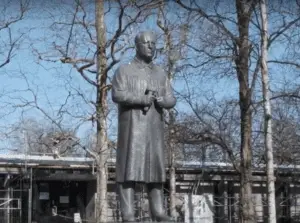One of my favorite places in Oslo is the sculpture garden in Frognerparken (The Frogner Park). I often come here to look at the sculptures or to hang out in the park. Here is a short intro of Gustav Vigeland and the story behind the park.
—> You might also like:The Vigeland Museum – A Hidden Gem in Oslo
Gustav Vigeland

The sculptures in the park were made by the artist Gustav Vigeland (1869-1943). He was born in Mandal in the southern part of Norway, and grew up in a very religious family. Already in early age Gustav revealed his talents of drawing and woodcarving. When he was fifteen years old his father brought him to Oslo to apprentice him to a master. Except for a short period at the School of Design in Oslo Vigeland never attended any formal art academy. However, he traveled extensively throughout Europe and worked together with many leading artists at that time. He was inspired by Homer and the ancient Greek dramas, but also studied a lot of anatomy and art. He was particularly fond of the sculptures of the Danish artistBertel Thorvaldsen.
Vigeland’s talents were soon to be recognized, and he was hired in the early 1900s to create many portraits of prominent Norwegians and as well commissioned for several memorials.
In 1921 the Oslo municipality were to show him exceptional generosity by providing him with a new and spacious studio close to todays Frogner Park. In return Vigeland was to give all the art he created to the city, including all art in his possession as well as original models of future sculptures. Vigeland lived and worked in this studio until his death in 1943. Todaythe studio is openas a museum displaying many of his works, and it is also the mausoleum of the artist himself.
 Sinnataggen (the angry boy) an icon for the park
Sinnataggen (the angry boy) an icon for the park
Vigeland Sculpture Park
The Vigeland park contains 214 sculptures and 758 figures. All of them were modeled in full size by Gustav Vigeland. The idea behind the sculpture garden started already in the year 1900 when Vigeland had made a model of six men carrying a big bowl of water as part of a fountain. He was initially hoping that the city would order the fountain for a minor square in town, but before getting any response to his proposal he already had the idea of a much bigger fountain. This one he developed during the next years and it was presented to the public in 1906. In 1907 it was decided to put the fountain in front of Stortinget, the Norwegian Parliament.

However, in the meantime Vigeland came up with the plan for a series of granite groups to be added to the fountain. In 1916 he showed his new plans to the Municipal council, and once again they won public acclaim. The current fountain and granite groups would no longer fit in front of the Parliament building, and it was decided to put the installation in front of the Royal Palace.
当维格兰承诺他的新工作室在1921年he changed his plans again and proposed to put the fountain, the granite groups and the latest addition, the Monolith, on the site outside of his studio. The Municipal council was not satisfied with this solution and in 1922 they asked Vigeland to make a plane for placing his installation in connection with the Frogner Park. Vigeland came up with a new plan, and after two years of heated debate it was approved in 1924.
The rest is history. The Vigeland installation became his lifelong work until he died in 1943. The park opened a few years later.
The Vigeland Park on YouTube
Since I don’t want my guide knowledge to go to waste while everyone is self-isolating this season, here’s a quick tour of Frognerparken in Oslo! Walk with me amongst the over 900 sculptures and figures in the Frogner Park, all done by one artist: Gustav Vigeland (1869-1943). Can you spot Sinnataggen (The Angry Boy)?
Watch the videohere.
Pål
You might also like:The Vigeland Museum – A Hidden Gem in Oslo





